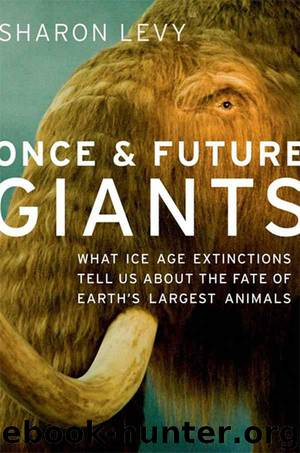Once & Future Giants: What Ice Age Extinctions Tell Us About the Fate of Earth's Largest Animals by Sharon Levy

Author:Sharon Levy [Levy, Sharon]
Language: eng
Format: epub
Tags: Life Sciences, Ecology, Science, Nature, Environmental Conservation & Protection, Paleoecology - Pleistocene, Wildlife Conservation, Pleistocene, Paleoecology, Effect of Human Beings On, Mammals - Effect of Human Beings On, Extinction (Biology), Hunting; Prehistoric, Prehistoric Peoples, Paleontology, Endangered Species, Mammals - Conservation, Mammals, Biology, Paleontology - Pleistocene
ISBN: 9780195370126
Publisher: Oxford University Press
Published: 2011-03-22T00:00:00+00:00
Fig. 22 Some advocates of Pleistocene rewilding dream of bringing African cheetahs to the western United States, to replace the extinct American cheetah, which coevolved with the speedy pronghorn. (Photo by James Temple, from Wikimedia Commons, http://en.wikipedia.org/wiki/File:TheCheethcat.jpg)
Even native wildlife can cause alarming ripples of change when they move into new territory. In recent decades, white-tailed deer, which once roamed only east of the Mississippi, have invaded the West. Irrigated fields of alfalfa and sweet clover in the Columbia River basin have created ideal whitetail habitat where it never existed before. During the winter, white-tailed deer stay down in the valleys and don’t have much impact on mule deer, which are native to the western mountains. But in summer, the whitetails migrate out of the low country and into higher elevations. Cougars follow white-tailed deer into places they would otherwise seldom visit. There they prey indiscriminately on both species of deer. In the Selkirk Mountains, where the boundaries of Idaho, Washington, and British Columbia meet, the resulting influx of cougars has caused mule deer to dwindle and threatens a highly endangered population of mountain caribou, the last in the United States.
To protect mule deer and caribou, state wildlife managers decided to intensify cougar hunts in the Selkirks. The strategy backfired, however, because it failed to account for the subtleties of cougar society. Hunters target mature male cougars, the most prized trophies for humans. Without adult males to keep the younger generation in line, young males kill infants they did not father, a strategy that makes females available sooner for mating. Given this risk, a mother cougar would rather move than lose her young. Robert Wielgus of Washington State University’s Large Carnivore Conservation Laboratory found that heavy cougar hunting thus led to a greater loss of the species the humans had intended to protect. Female cougars, pushed by an influx of infanticidal males, moved to higher elevation. There, the mother cats preyed heavily on mule deer and caribou.13
Any sort of rewilding, whether it focuses on the time of Columbus or the era of the mammoth, will ultimately hinge on finding ways for humans to coexist with big predators. So far there has been little success. Most wildlife managers still believe the long-standing dogma that hunting adult males will not affect the viability of a predator population, though Wielgus has documented a syndrome of destabilized social systems, leading to a decline in reproduction, among grizzlies as well as cougars.14 Another dogma holds that wolves, which reproduce much faster than most large carnivores, can survive intense hunting pressure. While this is true, studies of wolves in protected areas, including new work on the Yellowstone wolves—where some individuals live to the ripe old age of ten years or more—make it clear that wolf societies can be shattered by heavy harvest.15 Wolves living in stable packs learn sophisticated hunting techniques from their elders, enabling them to hunt more efficiently. By contrast, in places where hunting is permitted, wolves seldom survive more than three or four years and tend to live in small, shifting coalitions instead of cohesive family groups.
Download
This site does not store any files on its server. We only index and link to content provided by other sites. Please contact the content providers to delete copyright contents if any and email us, we'll remove relevant links or contents immediately.
Sapiens: A Brief History of Humankind by Yuval Noah Harari(14221)
The Tidewater Tales by John Barth(12595)
Mastermind: How to Think Like Sherlock Holmes by Maria Konnikova(7198)
Do No Harm Stories of Life, Death and Brain Surgery by Henry Marsh(6875)
The Thirst by Nesbo Jo(6809)
Why We Sleep: Unlocking the Power of Sleep and Dreams by Matthew Walker(6598)
Life 3.0: Being Human in the Age of Artificial Intelligence by Tegmark Max(5447)
Sapiens by Yuval Noah Harari(5281)
The Longevity Diet by Valter Longo(5008)
The Body: A Guide for Occupants by Bill Bryson(4954)
The Rules Do Not Apply by Ariel Levy(4824)
The Immortal Life of Henrietta Lacks by Rebecca Skloot(4504)
Animal Frequency by Melissa Alvarez(4382)
Why We Sleep by Matthew Walker(4342)
The Hacking of the American Mind by Robert H. Lustig(4306)
Yoga Anatomy by Kaminoff Leslie(4289)
All Creatures Great and Small by James Herriot(4213)
Double Down (Diary of a Wimpy Kid Book 11) by Jeff Kinney(4183)
Barron's AP Biology by Goldberg M.S. Deborah T(4082)
